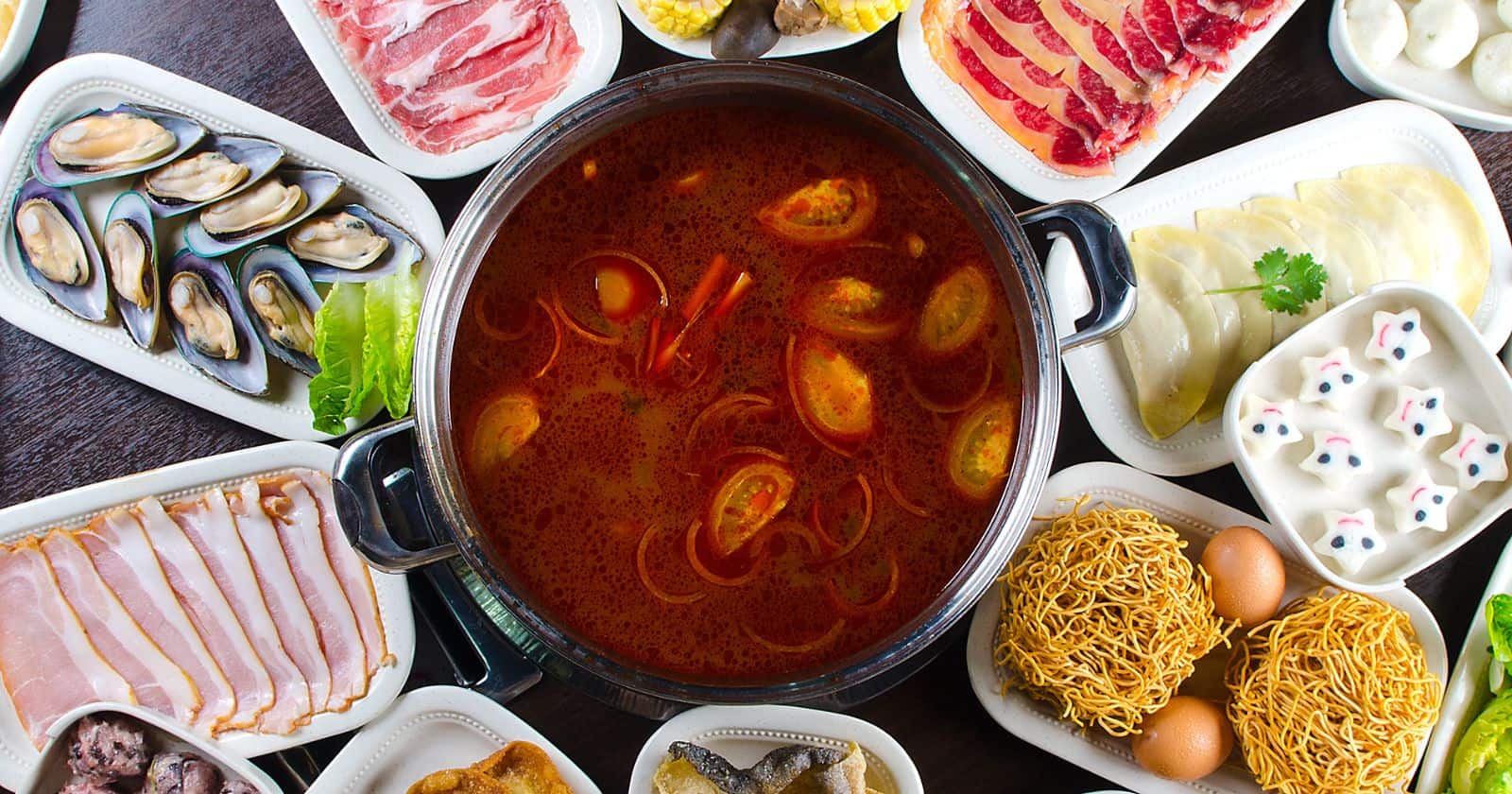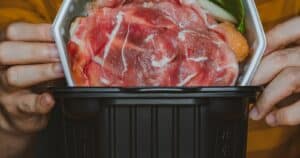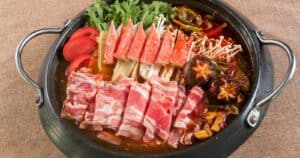Searching for a fun, interactive dining experience? Hot pot and steamboat are two popular communal cooking styles, but what’s the difference between dipping thinly sliced meat into a bubbly broth or a steaming cauldron of soup? As a foodie, I used to get these Asian hot pot variations confused until I learned more about their origins and preparation methods.
While hot pot and steamboat share similarities like cooking ingredients in boiling soup at the table, their broth bases set them apart. Hot pot broth is typically spicy and loaded with chili oil, garlic, Sichuan peppercorns, and numbing Sichuan peppercorn powder. This gives the broth a kick and infuses it with intoxicating aromas. Steamboat broth is more comforting – clear and mild chicken or seafood broth perfect for showcasing the natural flavors of fresh ingredients.
The ingredients also differ. Hot pot favors thinly sliced beef, lamb, seafood, leafy greens, and noodles, while steamboat highlights seafood like shrimp, fish, squid, and shellfish. Despite their differences, both experiences are highly social and let you play chef, cooking morsels to your liking.
Ready to gather friends and get dipping? Read on as I unravel the nuances between hot pot and steamboat, from storied origins to modern-day renditions around the world. By the end, you’ll be equipped to choose your perfect communal dining adventure.
Tracing the Historic Origins and Cultural Importance
While hot pot and steamboat share the fun, interactive element of cooking in boiling soup at the dining table, their origins and cultural significance differ.
Hot Pot History – Keeping Mongolian Nomads Warm
Hot pot originated centuries ago in Mongolia and China.
During cold winter months, Mongolian nomads would huddle around a boiling pot of soup perched atop a small fire stove. This kept them warm while cooking sliced meat and vegetables in the broth.
Over time, the tradition spread to Southern China’s Sichuan province, where it transformed into the spicy, chili-laden hot pot we know today. Hot pot became ingrained in Chinese culture as a way to bond over shared meals during long winters.
Beyond practicality, Chinese hot pot took on additional meaning:
- The communal experience represents family and relationships. Gathering around the hot pot symbolizes intimacy and unity.
- Ingredients added symbolically – fish balls for prosperity, thinly sliced meat for longevity, leafy greens for wealth.
- Cooking in a fiery broth represents a fresh start and washing away the old year. A clean slate for the new year.
So for the Chinese, hot pot warms bellies and brings people together during the coldest months. The meal carries deep cultural resonance.
Steamboat History – Cantonese Ingenuity
Steamboat originated in southern China’s Canton province in the 1950s.
When the province faced extreme food shortages, Cantonese chefs ingeniously created “steamboats” to stretch limited ingredients. They simmered vegetables, small amounts of meat and seafood in steaming broth. This fed more people and infused simple ingredients with flavor.
Over time, steamboats evolved into the lavish seafood feasts we know today. But the communal, healthy essence remains. For Cantonese, steamboat reminds them of hardship and ingenuity. The simple soup broth allows fresh, high quality ingredients to shine.
So while hot pot warms the body, steamboat warms the soul and celebrates freshness. The communal experience nods to Cantonese heritage.
Comparing Broths: Spicy Hot Pot vs. Clear, Light Steamboat
The biggest difference between hot pot and steamboat lies within the broth bases swirling in the pot.
Hot Pot Broth – Spicy, Flavor Packed
The hallmark of Sichuan hot pot lies within its fiery broth. It contains:
- Chili oil – infuses the broth with a fiery red hue and spicy kick
- Sichuan peppercorns – gives the broth a tongue-numbing effect
- Spices and herbs – garlic, ginger, cilantro stems amp up aromatics
- Sichuan peppercorn powder – creates a numb, tingling mouthfeel
This strong depth of flavor permeates the hot pot ingredients cooked within. The pot bubbles furiously, intensifying the aromas and spiciness. You’ll emerge with numb lips from the feisty broth!
Besides the classic Sichuan version, hot pot broth variations include:
- Miso – thick, creamy Japanese broth made from fermented soybean paste
- Tom yum – Thai style hot and sour broth infused with lemongrass, kaffir lime leaves, galangal
- Kimchi – Korean hot pot broth mixed with fiery fermented cabbage
So hot pot broth packs a punch! The bubbling chili-laced soup is the star of the show.
Steamboat Broth – Light, Clean
In contrast, steamboat broth plays a supporting role – gentle enough to let ingredients shine. Classic versions include:
- Chicken broth – mild, subtly infused with chicken essence and minimal seasoning
- Seafood broth – light broth made from shrimp shells, fish bones
- Mushroom broth – earthy broth slow simmered with dried mushrooms and herbs
- Herbal broth – Chinese medicinal herbs like red dates, goji berries, ginseng
The goal is clean, light broth to highlight the freshness of ingredients cooked within. Steamboat broth is all about simplicity and purity.
Taking the Plunge: Hot Pot vs. Steamboat Ingredients
Once you select a flavor packed hot pot broth or a light steamboat broth, it’s time to add the main ingredients.
Hot Pot – Thin Sliced Meats, Leafy Greens
Hot pot ingredients are all sliced super thin so they cook quickly in the simmering caldron. Popular hot pot additions include:
- Thin sliced beef – ribeye, brisket, tripe
- Thin sliced lamb – leg, shoulder, belly slices
- Leafy greens – chrysanthemum greens, spinach, bok choy
- Mushrooms – shiitake, king oyster, enoki
- Seafood – shrimp, squid rings, fish balls
- Tofu products – silken tofu, fried bean curd
- Noodles and dumplings – rice noodles, wontons, fish balls
Dunking thinly shaved meats into the hot broth cooks them in a flash while infusing with
Steamboat – Seafood, Meatballs, Dumplings
Since the broth doesn’t carry much flavor, steamboat highlights premium ingredients like:
- Seafood – shrimp, scallops, fish, crab, lobster, mussels
- Meatballs – handmade pork, chicken, or fish balls
- Dumplings – shrimp, pork wontons, fish balls
- Mushrooms and tofu – maitake, beech, fried beancurd
- Eggs – cracked raw into the broth
- Rice cakes – chewy drowned cakes
The pristine broth allows the natural seafood sweetness to shine. Dumplings and fish balls infuse more flavor. Vegetables are less common since the soup won’t permeate much flavor.
Preparation Differences – Quick Dip vs. Simmer
Prepping and cooking ingredients for hot pot vs steamboat also differs:
Hot Pot
- Ingredients sliced paper thin for quick cooking
- Quickly dunk ingredients into the simmering broth to cook
- Remove immediately once cooked to avoid overcooking
- Dip cooked items into sauce before eating
Steamboat
- Seafood, meatballs, dumplings kept whole
- Gently lower items into the hot but not rapidly boiling broth
- Let ingredients simmer until fully cooked through
- Lift out and eat as is, no dipping sauce
Regional Variations Across Asia
While hot pot and steamboat originated in China, the cooking styles spread across Asia, each with regional twists.
Sichuan Hot Pot
Sichuan province puts the fiery in hot pot. Hallmarks include:
- Malatang – spicy broth with myriad ingredients
- Yuanyang – pot divided into half spicy, half mild broth
Chongqing Hot Pot
The “hot pot capital” with distinctive traits:
- Extremely spicy broth – extra chili oil and Sichuan peppers
- Mala flavoring – perfect balance of chili heat and mouth-numbing
- Blood cubes – congealed pork or duck blood
Japanese Shabu Shabu
Japanese hot pot features:
- Mild broth – kombu and bonito dashi broth
- Rolled thin sliced meats – rolled vs. shaved slices
- Balance of flavors – ponzu and sesame dipping sauces
Thai Tom Yum Hot Pot
Thai style hot and sour hot pot includes:
- Tom yum broth – spicy, sour lemongrass based broth
- Thai herbs and spices – kaffir lime leaves, galangal, Thai basil
- Coconut milk – adds rich creaminess
- Fresh seafood – prawns, squid, fish
Korean Spicy Bulgogi Hot Pot
Korea’s hot pot highlights:
- Bulgogi broth – kimchi based broth
- Bright veggies – mushrooms, napa cabbage, sweet potato noodles
- Marinated bulgogi meat – thin shaved marinated beef
Frequently Asked Questions
What are the health benefits of hot pot and steamboat?
Both cooking methods can be quite healthy as they use lots of vegetables, lean proteins like seafood and chicken, and broth as a base. With homemade broths, you control the sodium content. Go easy on dipping sauces to prevent excess salt and calories.
Which is better for groups and special occasions?
Both hot pot and steamboat make fantastic group meals for special occasions since sharing food is central to the experience. Steamboat may be better for larger groups since ingredients are added more slowly versus all at once with hot pot.
What equipment do you need for hot pot and steamboat at home?
You’ll need a portable electric or induction cooktop, a plug-in hot pot or steamboat pot, long cooking chopsticks, wire strainers or spider skimmers, small bowls for ingredients, and dipping sauce bowls.
How can you stay safe when cooking hot pot or steamboat at home?
Use a well-ventilated area, don’t overload the pot, keep an eye on children around the boiling broth, use separate utensils for raw and cooked foods, and refrigerate and reheat leftovers properly.
What are good dipping sauces?
Popular hot pot dipping sauces include sesame sauce, ponzu sauce, soy sauce with garlic or chili oil, and Sichuan numb-spicy mala sauce. For steamboat, any sauce can overpower the pristine broth – just a touch of soy, chili oil or garlic oil works.
Choosing Your Feast: Hot Pot vs. Steamboat
With this breakdown of similarities and differences, you’re ready to choose between hot pot and steamboat for your communal dining experience!
Craving spicy intensity? Go for hot pot and its fiery, intensely flavored broth that permeates ingredients rapidly cooked within. It’s about warmth,
Seeking light purity? Opt for steamboat and its gently flavored broth that lets premium ingredients shine through. It’s all about simplicity, freshness and embracing natural flavors.
When planning your feast, think about these factors:
- Broth taste – spicy, numbing or light and pure?
- Ingredients – thinly sliced meats and tofu or premium seafood and dumplings?
- Cooking method – quick searing or gentle simmering?
- Flavors – boldness or subtlety?
- Vibe – lively spicy excitement or relaxed gentleness?
Once you select your broth, ingredients and cooking method, gather your closest friends and family to bond over your bubbling mini cauldron. Let the shared cooking and dining forge intimate connections. savor the rich flavors and heritage encapsulated within each bite.





